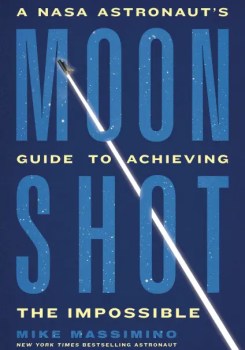Speak Up! And Other Lessons Learned From Being An Astronaut
A former NASA astronaut reflects on his career and what it taught him about overcoming steep challenges.
The following is an excerpt from Moonshot: A NASA Astronaut’s Guide to Achieving the Impossible by Mike Massimino.
When you purchase products through the Bookshop.org link on this page, Science Friday earns a small commission which helps support our journalism.

Moonshot: A NASA Astronaut's Guide to Achieving the Impossible
On STS-125, my second mission to Hubble, one of my primary tasks was going to be the removal and replacement of Hubble’s gyroscopes, the rate sensor units, or RSUs. Replacing the RSUs had already been done successfully on two previous Hubble servicing missions, but it was a tricky procedure. It required that I carefully go inside the most delicate area of the telescope, the navigation area with gyros and star trackers. There I would remove cables from the RSUs, and then carefully hand those RSUs to my spacewalking partner, Mike Good, outside the telescope. Then, while continuing to avoid bumping all these delicate instruments, I would carefully seat the new RSUs inside the telescope.
Handing the RSUs in and out from inside the navigation area was the dicey part. My reach and visibility would be constrained, it was hard to move in there, and even the slightest bump of the star trackers—which were within an inch of the trajectory—could render the telescope useless. It could knock the alignment system of Hubble out of whack, disabling its ability to point accurately into the heavens. It was like playing that game Operation, only if you made a mistake, instead of setting off a loud buzzer, you’d destroy a billion-dollar piece of hardware. But because it had been done this way in the past, we all accepted that this was the way it had to be done.
All of us, that is, except the rookie. Drew Feustel was a novice spacewalker assigned to STS-125. Drew had joined the Astronaut Office a few years before, and—there’s no other way of putting this—Drew’s a little different. But in a very good way. He just sees the world from a unique perspective. He’d worked his way through college as a car mechanic, and he was a genius with anything mechanical. When we looked at a piece of machinery together, I saw a piece of machinery. Drew saw a work of art. Today he’s one of my best friends, and he eventually became chief of the Astronaut Office, the big enchilada, the boss.
We trained for our space walks in the Neutral Buoyancy Laboratory (NBL), NASA’s gigantic pool measuring a hundred feet wide by two hundred feet long by forty feet deep. It’s where you can don a spacesuit, get lowered into the water, and work with high-fidelity mockups and tools while floating similarly to the way you’ll be floating in space.
When I first came to NASA, I thought a more appropriate name for this training facility would have been “Big Giant Pool.” But as time went on, I learned why it was called a laboratory. It was a building intended and equipped for figuring out solutions to difficult spacewalk problems. A place to experiment with and try out new ideas.
Drew could look at a task and almost instinctively know the best way to get the job done. So, as he watched me and Bueno train for this absurdly risky RSU task in the NBL, he realized what was wrong and he did what he was supposed to do. He spoke up. He pointed out that the way we were moving the RSUs in and out of the telescope was not only difficult but also inefficient and potentially dangerous. He then went on to draw a sketch of a new tool, based on a toy in his sons’ toy box. He called it a “Grabber Tool.” John Grunsfeld named it the “Pick Stick.” It worked much like the children’s toy that had a similar name. The Pick Stick could be used by a spacewalker to reach into the telescope from the outside to extract the old RSUs. Then, once they were out, we could use the same Pick Stick to insert the new ones. Because the remove-and-replace part of the task would be performed from outside of the telescope, it’d be easier, quicker, and safer.
What Drew was proposing went against twenty years of Hubble spacewalk training. When he first started with his proposal, I was skeptical, as were some others on the team. But I also knew that it was important to listen to new ideas and hear them out. You don’t squash creativity before listening to the whole story. Drew’s idea made sense; it was worthy of a deeper look and evaluation. Our engineers even went to the toy store for the kids’ version of the tool so we could give it a quick concept check. Then they developed a prototype for the NBL. It worked extremely well, just as Drew predicted. We used the Pick Stick on orbit, and it performed well there, too. A new and better procedure was successfully implemented, thanks to a new person speaking up and the experienced people on the team being willing to listen.
Adapted excerpt from MOONSHOT: A NASA Astronaut’s Guide to Achieving the Impossible by Mike Massimino. Copyright © 2023. Available from Hachette Books, an imprint of Hachette Book Group, Inc.
Mike Massimino is a former NASA astronaut, author of Moonshot: A NASA Astronaut’s Guide to Achieving the Impossible (Hachette Go, 2023), and a professor of Professional Practice in the Department of Mechanical Engineering at Columbia University in New York, New York.